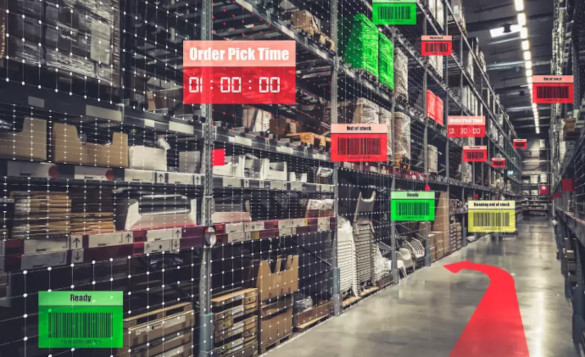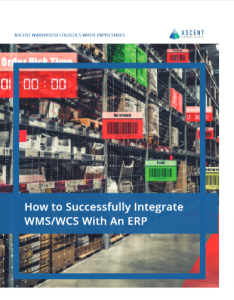
A warehouse management system (WMS) is a software solution used to optimize warehouse and distribution center operations. WMS solutions are becoming increasingly common in wholesale, retail, eCommerce, 3PL, the life sciences, and large-scale manufacturing environments because they can track the storage and movement of inventory in real time, reducing manual errors, improving efficiencies, and increasing productivity overall.
This guide will provide an overview of what a warehouse management system is, how it can help your organization, the difference between a WMS and an Enterprise Resource Planning (ERP) software, and also show how a WMS can optimize complex inbound and outbound processes.
The guide also discusses how to choose the WMS that meets your needs and the overall business benefits a WMS offers.

Current Trends Impacting Supply Chains and Warehouse And Distribution Space
There are three significant trends currently impacting supply chains and warehouse and distribution space. These trends are: the shortage of warehouse and distribution space, labor availability, and accelerating e-commerce growth.
The shortage of warehouse and distribution space
Consumers are increasingly turning to online shopping and research suggests by 2025, an additional 1 billion square feet of warehouse and distribution space will be needed to keep up with this growing demand. But shoppers cannot wait for the build out of infrastructure; they want their orders fulfilled today. That is why more and more distribution center managers and supply chain leaders are working to maximize space in their current facilities. They are reconfiguring layouts to maximize vertical space and increase storage density while also implementing goods-to-person technologies including robotics, autonomous mobile robots (AMRs), and automated storage retrieval systems (ASRS).
Labor availability
The pandemic, competition from Amazon, and changing workforce expectations are all effecting labor availability. As a result, distribution center management and supply chain executives are seeking labor-saving solutions such as automation. In addition, they want to shorten the training time required to get their labor to productive rates sooner.
Accelerating e-commerce growth
Before the pandemic, e-commerce was growing steadily, but somewhat modestly. Then, in May 2020, e-commerce spending skyrocketed $82.5 billion—an increase of 77%. That expansion has continued and now nearly equals what was projected for the next four to six years’ growth combined. This unprecedented growth, coupled with the shortages in warehouse/distribution space and labor, is creating extraordinary challenges for supply chain leadership. Many are considering implementing a warehouse management system (WMS) and/or a warehouse control system (WCS) to meet these challenges.

Before implementing a WMS, it is critical to consider a few key factors. Most notably, a WMS must be thoughtfully integrated with existing external systems, any WCS already in place, and all other relevant peripheral systems.
What does the word “integration” mean in the warehouse and distribution center environment?
In the warehouse and distribution center environment, the word “integration” refers to communication between systems. Those systems could be software systems, hardware controls, or any other type of peripheral. When integrated successfully, these systems are able to work together using a well-defined language that consists of a specific set of questions and answers. Integrations provide a variety of business benefits. They allow applications from different suppliers to be combined to create the most effective implementation.
What systems do WMS and WCS integrate with and what is the role of each?
WMSs and WCSs can integrate with upstream and downstream external business systems. Most commonly, the external business system they integrate with is an upstream enterprise resource planning (ERP) system; however, in manufacturing environments, there may also be integrations with downstream external systems, such as material requirements planning (MRP) systems, shipping systems, or transportation management systems (TMS).
Generally speaking, an ERP is designed to manage processes across the entire business. It is the system of record for a wide range of processes, including financials, forecasting, procurement, order management, production planning, and resource management. Although highly effective for managing those processes, ERPs are usually not optimal for real-time workflow optimization within a distribution center or stockroom.
A warehouse management system (WMS) is a specialized application used to manage all of the inventory activity within a distribution center or manufacturing facility. Typically, a WMS interfaces with an ERP system, using information from the ERP to manage workflow and optimize processes. It tracks inventory, regardless of where that inventory is stored. For example, a warehouse might have inventory stored in carousels, VLMs, flow racks, and other shelving locations. A WMS can manage inventory in all of these areas and provide a fluent, fluid, and seamless transaction going from one to another. A WMS can also interface downstream, integrating with other systems, such as a TMS.
WCS stands for warehouse control system. Unlike a WMS, a WCS cannot manage all storage areas within a distribution center or manufacturing facility. Instead, it can only manage automation. This automation can take many forms, ranging from routing cartons or totes on a conveyor system to material handling equipment, such automated storage retrieval systems (ASRS), carousels, or vertical lift modules (VLMs). A WCS integrates with, communicates with, and controls these various automated material handling components within the overall solution. Any inventory in non-automated storage areas needs to be managed by an independent and separate WMS or ERP.
A WMS/WCS is typically more agile than an ERP. That is because a WMS/WCS has more tools and business logic available to manage and optimize workflows within a distribution center or stockroom. As a result, they are able to make localized improvements with far-reaching benefits for inventory control, customer service, assembly, QA, etc. Generally speaking, a WMS/WCS is also easier to change for adaptation to fluctuating business conditions.

Successful integration of a WMS or WCS with an ERP requires knowledge of the process flow and data flow within the operation. Then, it is necessary to identify and understand where the pain points occur. Every warehouse or distribution center has unique challenges. For example, some customize their ERPs to control allocation of inventory.
They might prefer to spread inventory across multiple orders, portioning some to every customer instead of applying an entire shortage to one account. For an ERP to dictate inventory allocation like this it must be integrated with a WMS/WCS so that the information can be shared efficiently and effectively. The ERP needs to tell the WMS/WCS what lot to allocate and pick and pack, and not only the quantity ordered, but also the distribution of that quantity across all of the orders. Understanding the unique role of each component—the ERP, WMS, and WCS—is vital. For instance, if an ERP is the system of record, the integrity of that system must be maintained.
What are the functional requirements that need to be defined with an ERP?
When integrating a WMS with an ERP, the functional requirements that need to be defined include any touch points between the two systems. These typically include the part master, receipts, orders, and uploads (put-away, pick/pack/ship, adjustments). Note: It is essential to identify the touch points in both directions—from the WMS upstream to the ERP, and from the WMS going downstream to the WMC or other peripherals. For example, if an ERP is the system of record for part number information, no downstream systems should be permitted to edit or create new part numbers. This is a best practice and ensures that the part number and part profile information are maintained in one system, the ERP.
In most cases, an ERP is also the system of record for procurement and order management and order entry. This receipt information is another touch point from ERP to a WMS or WCS. It is “inbound information” about inventory coming into the facility. There is also “outbound information,” which includes sales orders, production orders, and transfer orders, that require the system in a distribution center to pick the inventory and pack/ship it, or in a manufacturing facility, pick the inventory out of the stockroom and deliver it to assembly or the manufacturing floor.
Another important functional requirement to consider is inventory adjustment and deciding which system is the system of record for inventory is key. Some ERP systems can instruct a WMS or WCS to decrement inventory; however, it is more common for the WMS and WCS to be the system of record of where inventory is stored. The ERP system has the aggregate quantity on hand, but the WMS/WCS tracks the inventory at discrete locations and is best-suited for cycle counting, inventory counting, or physical counts.
What are the mechanics of integrating a WMS with ERP?
The basic mechanics of integrating a WMS with an ERP usually include staging tables, webservice, flat files, and other specific methods of integration depending on the ERP (e.g., RFC in SAP or message queues in other systems).
The term “staging tables” refers to database tables that are shared between an ERP and a WMS or WCS. These tables are either in the ERP database or the WMS or WCS database. They are called staging tables because they are not internal tables that the systems would use to process their own business logic and perform their own functions. Imagine a wall between these staging tables and the rest of the respective system. This imaginary wall, which is actually a gatekeeper requiring validation, ensures that a WMS cannot, for instance, directly update data in an ERP table. Likewise, an ERP cannot directly update data in a WMS table. Instead, all updates require a set of staging tables to protect both sides.
Integrating a WMS with an ERP often also requires webservices and flat files. The webservices needed are real-time and implementing them requires a special IT skill set. The flat file data can be in XML format so that it can easily be used in EBI transactions. Having lower-level systems that can create flat files in XML format can be a significant time-saver.
All of these methods of integration depend on the particular ERP being used. For example, most ERPs use remote function calls (RFC) for messaging, but others have their own unique message cues that must be adopted. Even so, the communication piece of integrating a WMS is fairly straightforward. The goal is that once a messages is sent by one system, the other system responds within the timeframe expected and all functions run according to spec.
Of course, not everything runs according to plan 100% of the time. This is especially true in distribution and manufacturing environments where tasks and processes are fast paced with many dependencies. Often, when one process doesn’t work perfectly, there is a domino effect. That is why, as part of the design phase of an integration, it is crucial to consider what could go wrong. In fact, working on error detection and recovery is a key part to any integration effort and usually, more time is spent designing the what-if scenarios than the actual touch points. This time and effort are worthwhile in the long run. Being able to detect and recover from errors in any integration can make the difference between a successful project with happy users and one where the users don’t want to even talk about their experience.
Integrating a WCS to an ERP or WMS
A WCS is a warehouse control system, and it can be integrated to an ERP, a WMS, or directly to material handling equipment, such as a VLM, a carousel, or an ASRS. There are some WCS systems that use a standard application programmable interface (API). These systems offer little flexibility in terms of integration and are not as complex as an interface to an ERP might be. In most cases, the WCS integration can be done with direct device control. That means, instead of communicating at a high level to another application, the integration can occur directly to material handling equipment. But since every equipment manufacturer has their own proprietary interface, it is critical to work with the equipment manufacturer to ensure understanding of the entire architecture.
Often the WCS is integrated to control inventory within these devices. For instance, in a vertical carousel, a WCS could manage each bin location, keeping track of what and how many is stored in each of those locations. An ERP is not well-suited for this type of inventory management. A WCS, by contrast, can communicate to the device so that the needed items are brought to the operator, but the WCS can only manage the inventory within that device.
What about inventory that isn’t stored in a device managed by a WCS? This is where the integration between a WCS or WMS and ERP comes into play. Without integration, a WCS or WMS could be managing movement of inventory in certain locations, while the ERP is managing aggregate inventory, without any knowledge of where that inventory exists in real-time. Integration solves that problem by ensuring all of these components work together to optimize workflows and processes.
What Additional Factors May Come into Play When Integrating A WMS Or WCS?
When integrating a WMS or WCS, it is also important to consider additional factors such as replenishment, slotting, and shelf life. In most cases, the replenishment transaction originates within ERP, and then the information is sent from ERP to the WCS. That way, the WCS learns that the inventory is coming and can find the right location to store it. Slotting involves using the WCS or WMS to determine optimal locations to store inventory. The main elements that factor into slotting are capacity, velocity, and dimension. Capacity refers to the number of items that need to be stored. Velocity refers to how long the item is expected to stay in storage. (Items that are picked and shipped quickly should be stored in the most easily-accessible location.) Dimension refers to the dimension of the item being stored, as well as the dimension of the location that’s available to store that item. Shelf life and whether FIFO is a requirement can also factor impact WMS/WCS integrations.
Integrating a WMS or WCS with peripherals
Peripherals are pieces of hardware that are used in the process flow of a distribution center or warehouse. Examples of peripherals include print-and-apply machines, barcode printers, weigh scales, X-ray machines, and devices used for reeled inventory in SMT shops. Each one of these peripherals generally has its own interface. So before integrating a WMS or WCS, it is essential to contact the OEM manufacturer or at least refer to the interface manual to ensure that the proper integration steps are followed. These devices use either a serial connection, an RF232, or a network connection. In today’s warehouse environments, most peripherals are networked; however, there are still some devices that only support serial connections. That is why it is important to know which interface is available and to order the proper equipment and associated kits to support that interface.

Why it’s critical to consider long-term business objectives and trends when implementing a WMS or WCS
It is a mistake to build a WMS or WCS based solely on current product mixes and order velocities. Instead, be sure to consider long-term objectives, as well as industry trends. Heed this cautionary tale: In the past, many distribution centers built their systems to exclusively convey cases. Now, they are struggling with ‘eaches’ due to e-commerce shifts. Ultimately, the best WMS/WCS design is one that allows the business to adapt to changes and variability within supply chains.
How do WMS/WCS solve for inventory management on a job or project basis?
Inventory management on a project basis is a matter of inventory ownership. Even if most inventory is tied to a specific job or a specific project, there is almost always some inventory that is used in common. This common stock is usually low-valued items such as nuts, bolts, and washers. Even so, it needs to be included in the conversation about integrating a WMS or WCS with an ERP.
What is a typical timeline for an integration to a WMS?
Timelines for WMS integration projects vary. A good ballpark estimate is two to three months from the start of the project cycle to being able to test the integration in a test environment. Three elements are required to begin the project cycle: an understanding of the various roles of the systems being integrated, defined touch points, and defined functionality. Once those three elements are place, it is possible to define the error conditions and how to automatically recover from them. All of this is part of the design effort. Ultimately, the design needs to be put into a test environment, so that the error conditions can be tested to make sure both sides recover. Testing like that takes additional time, but it is worth it in the long run.
Where can we find information about specific WMS/WCS integrations to VLMs or other hardware?
For more information about specific WMS/WCS integrations to VLMs or other hardware, reach out to the hardware manufacturer. Every manufacturer has their own interface, message formats, and other details specific to that interface. Talk to the manufacturer to ensure your integration proceeds as effectively and efficiently as possible.
